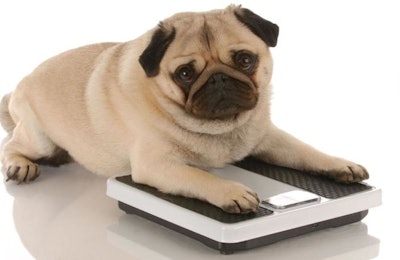
Headlines regarding pet obesity often follow at least one of two main themes: that many pet owners are in serious denial about their pets’ weight or that pet food may play a role. Of course, these are highly inter-related, because we humans often prefer to blame something else other than our own beliefs or behavior.
With pet food, both themes derive from the fact that many pet owners don’t really understand pet nutrition or the nutrients in pet food. And veterinarians often are unable to provide much help in that regard.
In the US as of 2015, about 58% of cats and 54% of dogs were overweight or obese, according to the Association for the Prevention of Pet Obesity’s (APOP) most recent survey of US veterinarians. In past surveys, APOP had focused on the “fat gap”: Despite veterinary assessments that their pets’ weighed too much, 90% of owners of overweight cats and 95% of owners of overweight dogs believed their pets’ weight was normal. Now the association is saying even veterinarians are confused or ill-informed.
APOP’s 2015 survey revealed a lack of consensus in the US veterinary community about the definition of obesity. Though the association defines clinical pet obesity as 30% of ideal weight, the definition varies among veterinarians, “industry stakeholders” (possibly including pet food companies?) and, obviously, pet owners. Another inconsistency lies with body condition score (BCS) scales. “There are currently three major BCS scales used worldwide,” said Julie Churchill, DVM, PhD, University of Minnesota veterinary nutritionist and APOP board member. “We need a single standard to ensure all veterinary health care team members are on the same page.”
Another obvious statement. APOP is urging the veterinary community, including in Europe, to standardize definitions and tools including the BCS. That may go only so far in addressing the fat gap in so many pet owners’ minds and perceptions, but it’s difficult to see how pet owner awareness and understanding of pet obesity can be improved if veterinarians aren’t on the same page and sending a consistent message.
That might also help pet food companies, not only in terms of formulating products designed to help with weight control but also in marketing and labeling them—in other words, developing their own messages. Actually, the same could be said for marketing and labeling any pet food products, due to so many misconceptions about pet foods and their ingredients. (Misconceptions that, ironically, are often created or at least fueled by some pet food marketing to start with.)
Demonizing pet food ingredients
In researching this topic, I came across a study by Mintel from a year ago, with its website blaring this headline: “One quarter of US pet owners worry pet food is making their pet obese.” The text below it fails to explicitly support that statistic; it does include other data that supposedly indicate a link between pet food and pet nutrition, if not obesity.
To wit: “Regarding pet nutrition, American pet owners are as concerned with what is not in their pet’s food as what is. More than half (55%) of pet owners are concerned about the amount of filler ingredients in pet food, such as grains and meat by-products. Nearly as many (49%) feel that the best diet for their pet is a ‘wild’ diet—allowing their pet to eat only what they would have eaten in the wild, such as all-meat diets without artificial ingredients.”
Talk about irony. The fact is, pet foods with high whole-meat content tend to be very nutrient dense, meaning less should be fed; yet most pet owners don’t understand that and tend to overfeed, thus increasing the risk of overweight or obese pets. It doesn’t help that feeding guidelines on some pet food bags are difficult to use or don’t apply universally to all pets, so pet owners often have difficulty following them.
On the other hand, meat by-products are among the most nutritious for dogs and cats. Yet demonization of them by pet food rating sites and other so-called online pet food experts—and some pet food companies themselves—leads to the widespread dissemination in the media and surveys that meat by-products are unhealthy “fillers,” causing pet owners to avoid them.
Yes, pet food definitely plays a role in pet obesity (final obvious statement), but perhaps not in the way many pet owners and veterinarians might think. As with so many other matters regarding pet food, it comes down to the need to better educate—with scientifically sound information—both groups about dogs’ and cats’ true nutritional needs and the various ways to fill them via pet food products. That’s certainly a tall task, but pet food companies might start tackling it by providing such information about their own products.



















